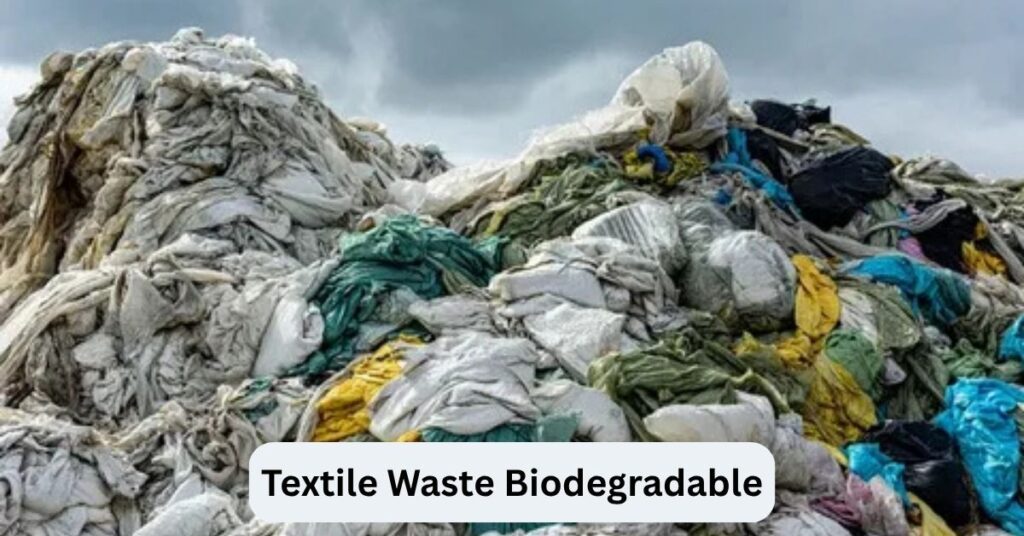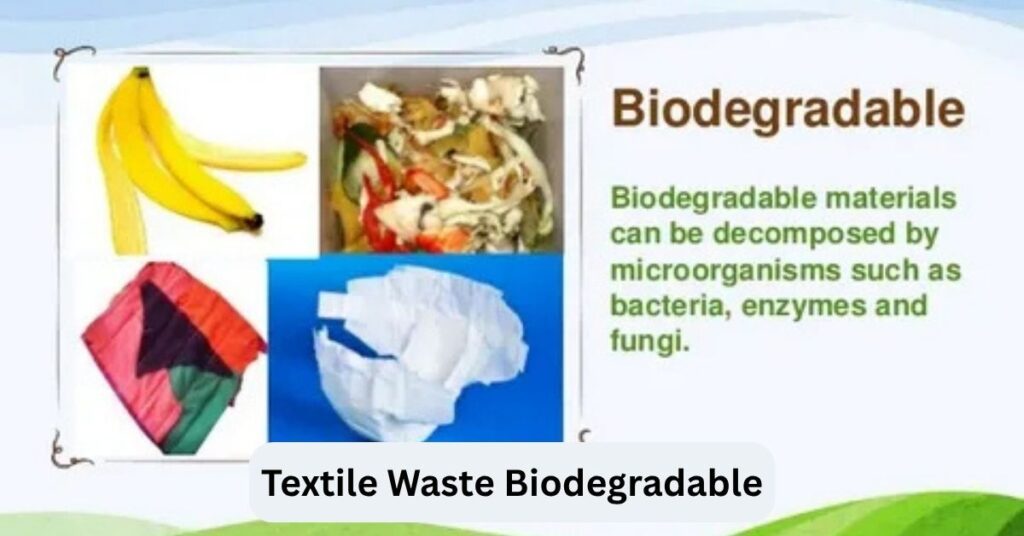Have you ever given a thought to what happens to your worn-out clothes once you dump them? They are discarded, and most of them end up in landfills, which also require decades or even centuries to decompose. And yet, imagine that we knew how to make that waste biodegradable, so that it would become something that benefits the earth as opposed to damaging it?
These steps should make it very clear how we can make textile waste more biodegradable, what practical tips to keep in mind and what products and solutions you can use, to transform your clothes into compose, not waste.
- How to Make Textile Waste Biodegradable in India
- How to Make Textile Waste Biodegradable in the Philippines
- Products Made from Textile Waste
- Chemical Recycling of Mixed Textile Waste
- Textile Waste Solutions That Work
- What Textile Waste Research Papers Say
- How to Recycle Textile Waste (Instead of Tossing It)
- Step-by-Step Guide: How to Make Textile Waste Biodegradable
- Real-Life Anecdote: A Shirt to Soil Story
- Why It All Matters
- Final Words
- FAQ's
How to Make Textile Waste Biodegradable in India
India is the largest textile manufacturing nation in the world, yet it is also one of the biggest generators of textile waste materials. Indians can also engage in effective waste reduction that could lead to sustainability as follows:
- Make clothing with 100 per cent natural fibre such as organic cotton, jute, hemp and banana fabric.
- Do not use artificial colourants; instead, use plant-derived or natural colourants.
- Accompany textile composting programmes in the city of Bengaluru and Pune.
- Use enzymes, such as cellulase, which are found in eco detergents, to dissolve cotton and linen quickly.
Learn more from India’s Textile Committee promoting eco practices.
How to Make Textile Waste Biodegradable in the Philippines
The problem of clothing waste in the Philippines is on the rise. Yet, neighborhoods and people are banding together to make a difference:
- Biodegradable fabrics should be used with a backyard composting system or other community composting system.
- Mix cotton clothes that used to be worn out with kitchen waste to be composted.
- Consider bokashi composting, which is a quick process and can be done in households in cities.
- Market products by using biodegradable materials such as pi- a ( Pineapple fiber) textile.
Explore the work of local innovators like Anthill Fabric Gallery, using Philippine indigenous materials sustainably.
Products Made from Textile Waste
What is one of the smartest ways to deal with textile waste? Make use of it. You would be surprised at what one can create with the recycled or biodegradable textiles:
- Shredded denim and cotton are used to make eco-insulation material.
- Handmade ornate carpets, bags and upcycled garments made of scraps.
- Hemp and banana leaf fibre packaging that is biodegradable.
- The textile and food waste home compost kits.
Brands like Ecoalf and Tonlé are already turning waste into stylish, functional products.
Chemical Recycling of Mixed Textile Waste

Well, how to deal with fabrics that are not compostable?
Here is the game-changer to chemical recycling:
- It separates mixed fibres, such as the use of polyester-cotton blends, into raw material that can be utilised repeatedly.
- Does not pollute with the usage of safe chemicals and closed loops.
- Can recycle low-grade fabric waste into good-quality yarns.
Read how Worn Again Technologies is revolutionising the field of chemical recycling of mixed textile waste.
Textile Waste Solutions That Work
These are the practical measures, as applied by people and brands these days:
- Fashion Zero-waste designing.
- Drop-off areas at the malls and shops, such as H&M.
- Donation of fabric swatches to the schools and local artisans.
- Purchasing fewer and higher-quality clothes that are not plastic but can biodegrade.
Platforms like Recovo let brands buy and sell surplus fabrics rather than discarding them.
What Textile Waste Research Papers Say
Sustainable textile strategies find their basis in academic research:
- Research shows that the biodegradation of cotton and wool occurs much more rapidly when it is subjected to enzyme processes, such as cellulase and protease.
- There has been a study of fungi-aided compost, which has promise with polyester blends.
- According to the soil microbe testing, natural textiles degrade 90 per cent quicker than synthetic ones.
Dive into Google Scholar to find published textile waste research papers on this topic.
How to Recycle Textile Waste (Instead of Tossing It)
It does not have to be all biodegradable. There are also instances when it is better to recycle:
- Mechanical recycling: used clothes are cut into fibres to make new yarn.
- Closed-loop systems: once you have used your items, send them back to the brand so that they can be reused.
- Participate in clothing exchanges, thrift shops or donation of old textiles.
- Search options such as Retold Recycling, where pickup and recycling of second-hand clothes are done.
Step-by-Step Guide: How to Make Textile Waste Biodegradable
Here is your 7-step plan:
- Avail natural fibres (you can purchase items made of cotton, silk, linen, wool, hemp).
- CUT them into small pieces so that they will dissolve more quickly.
- Remove buttons, zippers, or any kind of plastic.
- Put the bits in a compost bin or a corner of the garden.
- And mix with things that are organic, things like leftover fruit peels and leaves.
- It can be accelerated by the addition of enzymes or a compost starter.
- The fabric is expected to become nutritious soil after 3-6 months.
Use this soil to grow your own veggies or flowers!
Real-Life Anecdote: A Shirt to Soil Story
A 11-year-old Lahore-based eco-warrior, Fatima, once tore up her dad’s old cotton kurta and tossed it into the family’s compost bin. Four months on, the same t-shirt has become nutrient-rich compost that she has used to grow tomatoes for her backyard. Everyone around her was so amazed that they even started composting their own clothes, too!
Why It All Matters
If you have ever wondered, ‘What is in it for me?’ – read on:
- Rubbish skips are stuffed with non-biodegradable clothing.
- Synthetic fabrics produce microplastics that contaminate the water.
- Composting clothes belongs to enriching soil, not contaminating soil.
- Buying biodegradable items will lessen your eco footprint as it also helps to combat climate change.
Final Words
Making textile waste biodegradable is not just a green trend; it is a real way to protect our earth, save money, and live smarter. Whether you are in India, the Philippines, or anywhere else in the world, you can be part of the change.
So, the next time you hold an old shirt in your hands, do not throw it away. Turn it into something that gives back.
Ready to start? Grab a pair of scissors, find that old cotton tee, and give it a second life, one that ends in the soil, not the landfill.
Would you like this exported as HTML, PDF, or WordPress-ready content?
FAQ’s
What is the solution to textile waste?
There can be no one answer to the problem of disposed textiles, but the combination of recycling, large-scale use of naturally biodegradable materials, and responsible consumer choices is crucial. Brands and individuals may:
Use recycling systems in textile waste by some companies, such as H&M and Patagonia.
Promote products that were created by using textile waste, such as insulation or products made by eco-fashion brands.
Select natural materials such as cotton, hemp, or wool that break down more quickly.
Decrease clothing consumption and do not shop fast fashion.
Another option available is chemical recycling of mixed textile waste, where synthetic materials are broken down in order to be reused.
How to make biodegradable waste?
To make biodegradable waste, follow these steps:
1- Start with natural materials: Only organic items like food scraps, cotton, or paper can break down naturally.
2- Avoid synthetic blends: Polyester, nylon, and acrylic take hundreds of years to decompose.
3- Compost properly: Separate your biodegradable waste and place it in a composting bin with the right balance of greens (wet waste) and browns (dry waste).
4- Maintain conditions: Biodegradation needs heat, moisture, oxygen, and microbes to work efficiently.
If you’re asking specifically how to make textile waste biodegradable, the key is using natural fibres, eco-friendly dyes, and avoiding plastic blends.
Can textiles decompose?
Yes, textiles can decompose, but it depends on the material:
Natural fibres like cotton, wool, silk, and linen are biodegradable. They can break down in a few months to a couple of years, especially in composting conditions.
Synthetic textiles, such as polyester or nylon, are made from petroleum-based plastics. These can take 200+ years to break down and may release microplastics into the soil and water.
So, if you are aiming for eco-friendly fashion or disposal, stick to natural fabrics and learn how to recycle textile waste or compost it responsibly.

